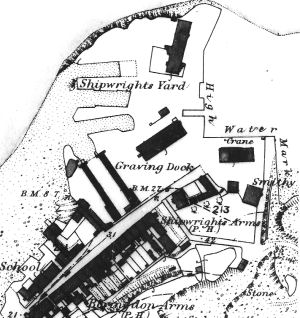|
OLD PLYMOUTH
. UK |
||
|
© Brian
Moseley, Plymouth Webpage created: April 18, 2018 Webpage updated: April 18, 2018 |
||
|
BRANCH LINE, FRIARY STATION TO TURNCHAPEL STATION TURNCHAPEL WHARVES An alternative name for this site is Turnchapel Dockyard. A Mr Isaac Blackburn was building boats at this site until 1826, when it was taken over by the Pope family and used for building and repairing ships. There is more information about this on the Ship Building and Repair webpage. The wharves were built by the Turnchapel Quays and Warehouse Company, owned by Mr Thomas Bulteel with the aid of his own Naval Bank. One of the quays was 315 feet in length and there were two others of 200 feet each and a much smaller one. The longest quay was meant to have a depth of 24 feet of water at ordinary spring tides but this had never been achieved as it was found that the river bed was extremely rocky. The site occupied about 6 acres and there were store houses capable of holding 12,500 tons of goods.
Turnchapel Wharves in the 1860s. By the time the Pope family ceased to use the yard in 1859 it was known as Turnchapel Dockyard. On Tuesday May 24th 1859 the Dockyard was put up for sale by auction. This was held at the Royal Hotel, Plymouth, under the direction of Mr S C Parkhouse. The site was described in the sales documents as having a water frontage of about a quarter of a mile. The Graving or Dry Dock, built of granite and ashlar, measured 192 feet in length and 52 feet in breadth at the entrance gates. Inside the engine house was a 2-horse-power engine with a large reservoir and pump to supply it. There was also a steam kiln and boiler house, also with a granite reservoir attached. Two 74-gun warships were constructed on the three building slips alongside the Wet Dock. Alongside these was a mast shed, 120 feet in length, with mould loft, counting house, offices and store cabins over; two treble saw pits; a slip for hauling up timber; a block and pump makers' shop, with a spacious smithy and coal store; a number of stone warehouses, with joiners' loft, sailmakers' and rigging lofts; a graving beach and a timber pond. Nearby was a dwelling house with a large garden and outhouses, used as the residence for the owner, plus three distinct properties for the leading men. The site later passed in to the hands of Messrs Pitts, Son and King, who made an effort to develop trade there. On May 17th 1899 the Plymouth Wharves (Ltd) was registered with a capital of £300,000 in £1 shares. None of the seven people involved were local. They were to carry on business as wharfingers; quay, pier, basin, dock and harbour owners and masters; warehousemen and proprietors of warehouses, bonded or otherwise; tug owners; ship builders; shipwrights; engineers; and ship and insurance brokers. The proposals did not proceed on the lines hoped for and the wharves did not become the busy hive of industry that had been expected. It appears that it passed back to the Bulteel family, in the form of the Turnchapel Wharves Company Ltd, and on Tuesday April 7th 1903 the Admiralty took possession of the Wharves and several acres of adjoining land for use as a coaling station for the Royal Navy. Occupiers were immediately confronted by members of the Metropolitan Police and instructed to remove their private property and the following day a Constable was placed in position at the top of the landing steps to check that the ferry man presented his pass.
|
||
